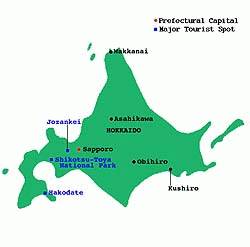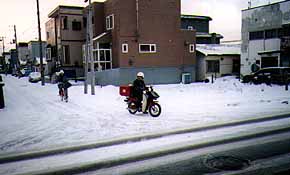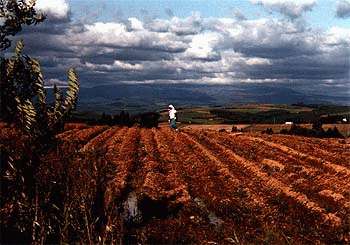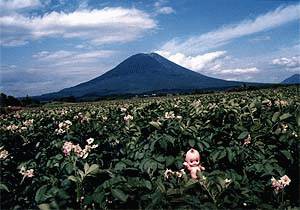Motorcycling in Japan
II

 Where
to Ride in Hokkaido
Where
to Ride in Hokkaido Where
to Stay
Where
to Stay Buying
a Bike in Japan
Buying
a Bike in Japan
 Getting
a License in Japan
Getting
a License in Japan Things
You Should Know
Things
You Should Know Guidebook
Guidebook
 Thinking
of Touring Canada?
Thinking
of Touring Canada? Links!
Links!
Notice
to Readers!
I left Japan in 1998, and have only
visited for short periods since then. When possible, I will update
this page with information when I become aware of it. It should be
noted, however, that information on this page may be out-of-date or inaccurate.
I am keeping this page up as long as I feel it might be helpful.
Any current information or corrections that readers may be able to provide
would be much appreciated.
Updated
May 2001
Where to Ride in Hokkaido

I'm going to assume
you are starting your trip from Sapporo, because that is the biggest city
in Hokkaido. Entry into Hokkaido would be by plane at Chitose, (30 minutes
to Sapporo), ferry at either Otaru or Tomakomanai, (about 1.5 hours from
Sapporo), or train directly into downtown Sapporo from the mainland.
Sapporo has a number
of bike shops. Stop by a bookstore and look for the Hokkaido only magazine,
"Do Bike," (title written in English) which lists lots of shops and has
pictures of bikes for sale. Also, pick up a "tsuringu mappu, (touring map)"
of Hokkaido that lists recommended motorcycling roads and accomodations,
(in Japanese only), and one other larger map with a bigger scale. Having
two maps gives you a different perspective -- sometimes roads that are
barely marked on one, jump out at you on another and turn out to be ideal.

My well-worn touring
map.
Stop at the international
travel center in either Sapporo Station, or at the one in the International
Plaza across from the clock tower. Both are staffed with English speakers
who are very helpful and friendly. BTW, next to the Clock Tower is a decent
bike accessory store called, strangely enough, AutoLand. You can buy helmets,
gloves, boots, locks, rainsuits and other accessories.
Sapporo can be done
in a day, and that may be stretching it. It's a nice place to live, but
doesn't offer much for the tourist, unless you come in February for the
Snow Festival -- but then the biking is shabby at best. The famous Clock
Tower is currently closed for renovation, and will not reopen until the
year 3251, when every board will have been coated in epoxy and re-attached
with custom-made titanium screws.
Remember, summer is
short in Northern Japan, so don't start a trip after August or before the
end of May, unless you don't mind some cold and quite likely rain. Snow
covers the island from late December to May, longer in the mountains. Bring
warm clothes even in the summer.

Neither wind, nor hail,
nor snow, etc, etc.
Obvious nut-case at work.
Good thing strict Japanese gun-control laws
keep guns out of hands
of postal workers here.
North West Hokkaido
Looking at a map of Hokkaido,
(and this part won't be of much use to you unless you have a map handy),
the coast runs up from Sapporo towards Rebun and Wakkanai on the left.
You will want to leave the city on either Route 275 or 231, avoiding route
12 at all costs. As a general rule of thumb, the more digits in a road
number, the less crowded it will be. Route 12 is a disaster. The mountainous
route, which would be 275, and then over to route 28, (which is not busy
despite its two-digit handle), is very nice. Follow 28 up to 451, and then
go left, (west) over to the coast. Follow the coast north from here, all
the way to Wakkanai if you want. An interesting excursion, if you have
time and want to drag some pegs, would be to take 233 inland from Rumoi,
out to Ebishima, (very small - station only), and then go North on the
poorly marked road (I know it has a number, but it's not marked on my map
-- I think its 8??), up to 239, and then back west out to the coast. This
is an example of a road that doesn't look very promising on the motorcycle
touring map, and in fact looks like it must be gravel, but turns out to
be an overlooked gem. Wakkanai is a forgettable little town, but the nearby
islands, Rishiri and Rebun are nice. Of the two, try Rishiri, which has
a nice 80 km ring highway around the mountain at its center. I also hear
good reports of the YHs on both islands.
If you want to go
to Asahikawa, which is famous for Ramen and hiking on the nearby mountains,
follow the same route out of the city as above. Just go right on 451 instead,
and then hook up with the dreaded 12 to Asahikawa.

Beatiful rolling hills
in Biei on the way to Asahikawa.
From Asahikawa, Daisetsuzan
Park and surrounding areas are very nice, especially in Autumn. Following
Route 39 out of Asahikawa will take you towards Kamikawa and Sounkyo, and
through some beautiful scenery. Be sure to get off and take a look around,
as the road is frequently covered by snow sheds and the scenery hard to
see. If you stop at Kobako or Obako, you can rent a bicycle (rip-off city:
¥1000 ) or just take a walk along the trail for a nice break.
If you want to go
to Biei and Furano, (recommended) follow the same route as above, but instead
of taking 12 up to Asahikawa, go from 451 to 38, which will take you into
some very beautiful country. Gorgeous rolling hills and beautiful flowers
can be seen in the summer. The shortcut of Route 70 to Biei is recommended
for dual-purpose bikes only as it is mostly gravel.

Furano Spring Flowers
North East Hokkaido
Shiretoko National Park,
on the right side of Hokkaido, is very nice. I would follow one of the
above routes up to Asahikawa, and then follow 39 up towards the coast.
Route 334 will take you to Shiretoko penninsula, (watch for deer). Definitely
check out Kamuiwakka Falls, a hot-spring awaits you at the top if you make
the climb. From Shiretoko, Abashiri is interesting, if only for its Meiji-era
prison -- definitely worth a visit.
South Hokkaido
A nice day trip from
Sapporo is Shikotsuko-lake, the deepest in Hokkaido. Take route 453 down,
although there are other, less crowded ways, I only know them by sight.
Still, 453 is nice, although crowded on weekends. Shikotsuko too is nice,
but camping grounds are very crowded.
If you're going to
Niseko and/or Yotei-zan Mountain, take route 230 south, then over to 276,
97 or 66 around the mountain. Yotei-zan is known as Hokkaido's Mount Fuji,
and is beautiful in the spring when the snow still caps the summit. This
route is also a good way to get out to the coast (and eventually Hakodate),
follow 276 or 5 westward, and then take one of the small roads along a
river valley out to the sea.

Mount YoteiZan -- Weird
we didn't notice that Kewpie when we took the picture....
Following Route 229
along the coast southernly, will take you to Hakodate. This is a sometimes
beautiful road, and I recommend this longer route if you are going to or
coming from Hakodate instead of the shorter route up the right side of
the coast, through Muroran. That is, from Hakodate, go west on 228, not
east on 278, (which turns into 5, then 37). Route 278 takes you through
miles of boring ugly fishing villages, and through the exceedingly ugly
industrial town of Muroran, before you finally get some relief at Toya
lake (take route 97 north from 37, then you can follow it up to 230 and
into Sapporo. Routes 2 / 453 and 230 / 132 are also a nice ride up to Sapporo).
West from Sapporo
-- Otaru and Shakotan
Otaru is a pleasant city
about 40 minutes by train from Sapporo, more than an hour if you ride.
National Route 5 is the only way there, and is usually packed. If you don't
like splitting lanes, allow at least two hours. You can save a bit of time
by taking 337 out of the city until it meets up with Route 5. An interesting
diversion from Route 5 is Route 1, which winds through the mountains, and
has a few very exciting hairpin turns. This will basically take you back
to Sapporo however. Otaru offers interesting Meiji-era warehouses and coffee-shops,
but nothing too exciting for an experience Japan-o-phile.
From Otaru, the Shakotan
penninsula is very nice, do-able in one very long bun-numbing day. After
Otaru, the crowds thin out, and if one of the tunnels doesn't crumble on
you, (they've been collapsing like cheap tents lately -- okay two have
failed), route 5 to 229, around the penninsula, and then back through the
mountains will make you very happy, except when you have to battle your
way back through the traffic again after Otaru.
To Top
Where to Stay
Okay, there's no denying
Japan is expensive. A fairly boring hotel in a big city can cost you ¥15,000
($150) easily. My advice is seek out Ryokan, (Japanese-style inns),
which cost from ¥3500 - ¥6000 a night per person, usually including
dinner and brekkie. What I usually do though, is stay in a Youth Hostel.
Japanese Youth Hostels are (sometimes) great. There are a few duds, but
most of them are pretty good. You don't have to be a youth, you can be
100 years old. I've never been bothered by any of the rules, (lights usually
out by around 10 or 11), but after a long day, you'll probably want to
sleep anyway. Cost is about ¥4000 including two meals per person. It's
also a great way to meet Japanese and get tips on local attractions. There
are over 400 YHs in Japan. Contact Japan
Youth Hostel Association, Suidobashi Nishiguchi Kaikan 5F, 2-20-7 Misaki-cho,
Chiyoda-ku, Tokyo 101, Phone 81-3-3288-1417.
Cost for a handbook
listing all the YHs in Japan is ¥400 , and can be bought at some YHs
or at tourist info centers in major cities. If you can't find a YH or want
to stay up late one night, business hotels can be found in most cities,
but have zero atmosphere and no meals. Costs are a little more than a YH,
about ¥5000, but can go up to ¥10,000. Better than a Business Hotel,
and far more interesting, are the Love Hotels. Usually about ¥4000
- ¥6000 a night, (or ¥2000 for a two-hour "rest"), they have a
far more interesting decor, and usually a much nicer bath. You don't have
to be a male-female couple to enter, but there will only be one bed. You
can usually choose the room from a wall of pictures in the lobby. Weird
and definitely worth trying at least once.
In Hokkaido, if you're
on a tight budget, check out the Rider's Houses. They offer a place to
flop you sleeping bag usually for under ¥1000. Look for signs on the
side of the road, or ask at a big bike shop for a book listing all the
Rider's Houses.
How do I get a Motorcycle?
What is available and what will it cost?
First off, forget about
a Goldwing or an FJ1100. Your best bet is a 400cc sport-touring bike, or
even better from a financial standpoint, a 250. Due to Japanese law, bikes
over 250cc cost more to insure, and bikes over 400cc cost even more, plus
require a special license to ride. That's why about 85% of the bikes you
will see in Japan are under 400cc. Since coming here, I've ridden a 2-stroke
Honda NS250, a NS400, a Yamaha TT250 off-road, a Honda CB400, a Kawasaki
ZZR400, and last rode a Yamaha 400 Diversion, (air-cooled four cylinder
four-stroke -- known as a Seca II and was sold in 600cc size in North America).
All of these bikes I have taken on extended tours, all riding two-up. Admittedly,
my passengers have always been small, but I am 6'4" and have never had
a big problem.
The best way to handle
this is to come to Tokyo or Osaka, and just buy a bike, with the understanding
that the dealer will buy it back when you leave. All dealers will buy used
bikes, but you will lose a lot of value. Expect to get about half of what
you paid. Selling bikes privately in Japan is quite rare, but it is possible.
It will probably take time though, so it's not practical. If you buy a
250, it will be easier because there is less paperwork with the insurance.
In 1997, I bought
a Yamaha Diversion, a used 1994 model with 10,000 kms. I paid ¥240,000
including two years of insurance, (actual price was ¥180,000). About
¥200,000 and up seems to be the going rate for a decent two or three
year old bike with low miles. Ridable bikes can be had for about half that
amount, but they won't be very new or pretty. It is not unheard of for
people to buy perfectly good bikes for only few hundred dollars, and I
have a friend who was given a bike, but you kind of have to be in the right
place at the right time.
When I left Japan
I could barely give my Diversion away. It had about 25,000 kms on
it, and the best offer I got from a dealer was 25,000 yen. I ended
up selling it to another foreigner for 40,000. You won't often see
bikes on the road that are much older than five years old.

Yoshiko and Emi on our
rental ZZ400 and CB400.
Renting is possible.
I rented a bike for four days in 1993. It was brand-new (zero kms!!!) Honda
CB400 (incidentally one of the best motorcycles I have ever ridden), and
cost ¥10,000 a day. For a short tour this may be the way to go, but
you never know what will be available, or how wild they will be about renting
to a foreigner. One last resource in the Tokyo area is Transcyclist,
run by a man named Volker Lenser, (hope I got your last name right Volker).
He arranges tours of Japan and can get rentals lined up. Fax him at 81-33402-5358
or write to him at TransCyclist, CPO Box 2064, Tokyo, 100-91. I have
no idea if this address is still current.
Thinking of Getting
Your License in Japan?? Yikes!!
If you already live here
and are thinking of getting a license, it isn't going to be cheap. I spoke
to Matt in Hamamatsu and this is what was involved in getting his Japanese
motorcycle license (1998) :
I enrolled in a driving
school here in Hamamatsu. It required 1 hour of lecture and testing, and
then 17 hours of practice. The riding practice has been going well so I
am fairly confident that I will pass the test, which by the way is offered
at the school. I didn't want to go to the city testing site, because the
testers are often referred to as ISHI-ATAMA, (stubborn, literally "rock-head").
I began the process
back in December. These are the steps, with expenses, that I followed:"
-
Translate my current US license with JAF -
¥3000
-
Go to the local police station to register
for a Japanese license - ¥2100
-
Take the car written test (in English) - ¥2100
-
Take the car driving test - ¥3500 (NOTE:
It was suggested to me by my employer that I get the car license first.
That way I wouldn't have to take a written test for the motorcycle, which
would be in Japanese.)
-
Enroll in a driving school (currently) - ¥150,000
(Just to let you know, this is about $1200 U.S. at current rates.)
-
Eye exam at license center - ?
-
Hopefully done (Editors note: Somehow, I doubt
it...)
UPDATE Reader Patrick E. reports in May 2001:
I wanted to drop you a line to say that I did manage to take a motorcycle
licence in Japan. This was achieved with zero knowledge of motorcycle and
almost as little proficiency in the Japanese language. It can be done!
I enrolled at the Hinomaru Driving School in Meguro-ku Tokyo with the help
of my secretary at work. It's a large, posh school but I must have been the
first foreigner ever due to the reaction. No English was spoken anywhere but
it turned out there was some-one in the back office who knew about 200 words
of English to help me along. I had started learning Japanese about 6 months
earlier so I could understand many key-words.
The general process which you quote from "Matt" are correct. 17 hours of
lessons (theory & practice) are required which enables you to take the final
test at the driving school instead of at the municipal testing site. The
latter is much cheaper though.
On test day, about a third of the Japanese candidates failed the driving
test but the sole gaijin passed...
So obtaining a license is a "mission impossible" sort of project,
frustrating at times, a great learning experience and satisfying in the end.

Things
You Should Know
-
Gasoline costs about ¥80 a liter (1998).
-
UPDATE, May 2001:
I've just been informed by a reader that riding two-up on expressways
is still illegal: "Unfortunately (the information I reported here on
being able to ride two-up on expressways)
isn't true yet. I have checked with the local police last
month and was informed that it is being studied now and may be changed in
the next year or two. However, it is not in effect yet. I checked with a
couple of other sources and found the same information. Anyway, I just
wanted to let you know so somebody doesn't get up on one of those
expressways only to get a ticket with their unhappy Japanese girlfriend..."
-
Big Mac, Fries and Coke costs ¥600. Average
meal prices: Breakfast, ¥600, (includes toast, egg, ham, coffee). Lunch:
¥800, no beverage. Dinner: from ¥800 to ¥50,000. A good meal
with a couple of beers would be about ¥3000.
-
 This is a stop sign
in Japan -- not a yield sign.
This is a stop sign
in Japan -- not a yield sign.
-
 You must stop
at all railroad crossings in Japan, gates or no gates.
You must stop
at all railroad crossings in Japan, gates or no gates.
-
 And this one
means no parking. If you're on a bike though, you can park on the sidewalk
or almost anywhere else. Just look to see where other bikes are parked.
And this one
means no parking. If you're on a bike though, you can park on the sidewalk
or almost anywhere else. Just look to see where other bikes are parked.
-
An international licence is almost ticket-proof,
but if you do get caught speeding, it's pricey. I paid ¥40,000 (about
$300 at that time) and lost my licence for 30 days in 1991 for riding 35kms
over, all because I showed my Japanese licence and not my International.
-
Japanese ride on the LEFT side of the road,
(or is it the right?).
-
Splitting lanes is common. Motorcycles can
ride up to the front of the queue at stop lights.
-
Be careful stopping for amber lights. Most
Japanese don't so always check your mirrors.
-
Helmets in large sizes are hard to find.
Even if you do find a larger size, the shape might be different from the
models sold overseas. A top quality plain Arai or Shoei will cost
you about $US250 (at least).
-
Things that are cheaper in Japan than Canada:
bananas, raw chicken, toilet paper, seaweed, photo reprints, cigarettes
($2 a pack), hard liquor.
-
Things that are more expensive: Everything
else.
-
Some ridiculous prices for everyday things:
A ten-kilo bag of rice: $42. One (big) apple: $2. Cup of coffee: $4, no
refills. Cantaloupe: $4, (very cheap) to $100.
-
Things you can't get here: Good deodorant.
-
Recommended Guidebook: Gateway to Japan,
Kodansha Press, 1998, June Kinoshita and Nicholas Palevsky. Newly updated
and very well-organized and reliable. I almost always agree with their
views on Japan and its attractions. It also has an extensive introduction
and history section. Too bad they changed the size from easy-to-jam-into-tankbag,
to big, bible-sized. Oh well, still a great guide.
-
As soon as you get here, pick up a special
motorcycle touring map book. They are available at most big book stores,
and are small enough to fit in a tank bag. There are about 8 different
ones covering different areas of Japan. They map out a recommended course
and provide notes on conditions and places of interest. Unfortunately they
are available only in Japanese. Ask for a "tsu-rin-gu map-pu," and see
the picture above so you know what they look like.
They are about ¥1000 each.
Interested in Riding
in Canada?
Glad you asked. I have
toured quite extensively in southern British Columbia, so if you're headed
that way, drop me a line. I also used to work for a motorcycle tour and
rental company, which I can definitely recommend. It's called the
The
Great Canadian Motor Corp,and you can reach them at 1-800-667-8865
in North America, Phone (250) 837-6500, Fax (250)837-6577. They rent all
kinds of bikes, from BMW R1100GS, to KLR650s, to Goldwings to Aces. They
also arrange guided tours or can set you up on a self-guided tour.

On a GCMC Goldwing in
the Canadian Rockies.
Japan
Youth Hostel Association
Kansai
Time Out Magazine - Good Source for Kobe, Kyoto Osaka Info
JET Program
Participants Home Page - Lots of Good Japan Links too!

Previous Page

Copyright© 2000 Sean Lewkiw
URL: https://members.tripod.com/~sean_lewkiw/

 Where
to Ride in Hokkaido
Where
to Ride in Hokkaido Where
to Stay
Where
to Stay Buying
a Bike in Japan
Buying
a Bike in Japan
 Getting
a License in Japan
Getting
a License in Japan Things
You Should Know
Things
You Should Know Guidebook
Guidebook
 Thinking
of Touring Canada?
Thinking
of Touring Canada? Links!
Links!








 This is a stop sign
in Japan -- not a yield sign.
This is a stop sign
in Japan -- not a yield sign. You must stop
at all railroad crossings in Japan, gates or no gates.
You must stop
at all railroad crossings in Japan, gates or no gates. And this one
means no parking. If you're on a bike though, you can park on the sidewalk
or almost anywhere else. Just look to see where other bikes are parked.
And this one
means no parking. If you're on a bike though, you can park on the sidewalk
or almost anywhere else. Just look to see where other bikes are parked.
